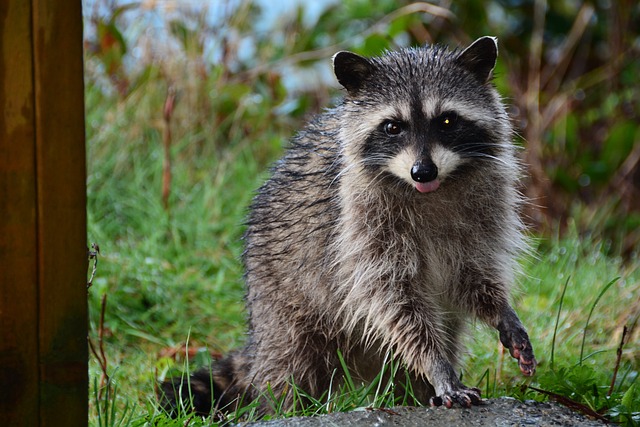Hey there! Have you ever wondered if raccoons are aggressive? Well, I certainly have, especially after a few unexpected encounters with these masked critters in my backyard. Raccoons are intriguing creatures that often pique our interest, but they can also raise concerns about their behavior, particularly when they venture a little too close for comfort. So, are they aggressive?
Raccoons are usually not aggressive but may act defensively if they feel threatened or when protecting their young. To peacefully coexist, respect their space, avoid provoking them, secure trash cans, and don’t feed them. Raccoons are valuable to our ecosystem and rarely pose a threat when left alone.
In this article, I’ll explore the ins and outs of these clever animals, dispel common myths about their aggression, and shed light on what factors influence their conduct. Let’s find out if they’re truly as aggressive as they sometimes seem. Let’s get started!
Understanding Raccoons
Before I dive deep into the question of raccoon aggression, let’s get to know these critters a bit better. Raccoons, scientifically known as Procyon lotor, are fascinating mammals native to North America. They are incredibly adaptable, which is why you can find them in various habitats, from lush forests to bustling urban areas.
One of the standout features of raccoons is their diet—they’re opportunistic omnivores. This means they’ll eat just about anything, from fruits and nuts to insects, small mammals, and even human leftovers. It’s this adaptability and their penchant for scavenging that often brings them into close proximity with humans.
But raccoons are more than just clever foragers. They have distinctive physical characteristics, like their distinctive black mask across their eyes and their bushy, ringed tails. These features give them a certain charm that has captured our imagination for generations.
Now that you’ve scratched the surface of who raccoons are, let’s explore the behavioral aspects that make them so intriguing, including the big question: are raccoons aggressive by nature?
Raccoon Behavior: Myth vs. Reality
Raccoons have garnered a reputation as mischievous troublemakers, but how much of this reputation is based on facts, and how much is pure myth? Let’s separate fact from fiction when it comes to raccoon behavior.
Myth 1: Raccoons are Always Aggressive Reality: Contrary to popular belief, raccoons are not inherently aggressive animals. In fact, they are often quite shy and prefer to avoid confrontation. They would rather flee than fight, given the choice. However, like any wild animal, they can become defensive if they feel threatened or cornered, which can lead to aggressive behavior.
Myth 2: Raccoons Attack Humans Unprovoked Reality: Raccoon attacks on humans are exceptionally rare and typically occur when raccoons are cornered, provoked, or defending their young. They are not naturally inclined to attack humans without reason. In most cases, raccoons will go to great lengths to avoid human interaction.
Myth 3: Raccoons are Nocturnal and Always Active at Night Reality: While raccoons are often active at night (they are primarily nocturnal), it’s not uncommon to spot them during the day. Raccoons are opportunistic feeders and may venture out in daylight to search for food, especially in urban areas where food sources are abundant.
Myth 4: Raccoons are Territorial and Aggressive Towards Other Raccoons Reality: Raccoons are not particularly territorial animals. They may have home ranges that overlap with other raccoons, and conflicts between them are usually resolved through posturing, vocalizations, and intimidation rather than physical aggression. They tend to avoid fights whenever possible to minimize injury.
Understanding these myths and realities is crucial for coexisting peacefully with raccoons. While they may have a reputation for mischief, it’s essential to recognize that their behavior is typically rooted in survival instincts rather than malicious intent. In the following sections, I’ll explore the various factors that influence raccoon behavior and gain a deeper understanding of when and why they might exhibit aggression.
Factors Influencing Raccoon Behavior
Now that I’ve debunked some common myths about raccoon behavior, let’s delve into the factors that shape how these creatures behave in the wild and in our neighborhoods. Understanding these influences can shed light on why raccoons may sometimes display aggression or other behaviors.
-
Environment and Urbanization
- Habitat Changes: Raccoons are highly adaptable, but urbanization has led to significant changes in their natural habitat. As humans encroach on their territory, raccoons may find themselves in closer proximity to people, which can influence their behavior.
- Food Availability: Urban areas often provide a smorgasbord of easily accessible food sources, such as garbage cans and pet food left outdoors. This can lead to raccoons becoming more accustomed to human presence and, in some cases, displaying bolder behavior.
-
Seasonal Behavior Changes
- Breeding Season: Raccoon behavior can change during the breeding season, typically in late winter to early spring. Female raccoons may become more protective of their young, which could lead to defensive behavior if they perceive a threat.
- Hibernation: In colder regions, raccoons may become less active during the winter months and seek shelter in dens. This seasonal slowdown can impact their behavior and interactions with humans.
-
Age and Gender
- Young Raccoons: Young raccoons, or kits, may display curiosity and playfulness but are generally not aggressive. However, they may become more cautious as they grow older and learn to survive in their environment.
- Gender Differences: Male raccoons (boars) and female raccoons (sows) may exhibit different behaviors. Males might be more territorial during mating season, while females focus on raising their young.
-
Health and Disease
- Rabies and Other Diseases: Raccoons can carry diseases like rabies, which can affect their behavior. Sick raccoons may act disoriented, aggressive, or unusually bold. It’s essential to avoid approaching raccoons that appear sick or behave erratically due to the potential health risks.
Understanding these factors can help us appreciate the complexities of raccoon behavior and take appropriate steps to coexist with them peacefully. While raccoons can adapt to various environments, their behavior is often shaped by the circumstances they encounter in the wild and in our urban landscapes.
Raccoon Aggression: Rare but Not Impossible
While raccoons are not naturally aggressive animals, there are situations in which they may display aggression. It’s essential to recognize these situations and understand the reasons behind such behavior. Here, we’ll explore when and why raccoons might become aggressive and how to identify potential warning signs.
-
Protecting Their Young
- One of the most common triggers for raccoon aggression is when a mother raccoon perceives a threat to her young. Mothers are highly protective and may defend their babies fiercely if they feel they are in danger.
- Warning Signs: If you encounter a raccoon with young kits, keep a safe distance. Signs of aggression may include hissing, growling, arching their back, or advancing towards you while baring their teeth.
-
Feeling Cornered or Trapped
- Raccoons are masters of escape, but if they feel cornered or trapped, they may resort to defensive aggression. This can occur if they are caught in a confined space or feel threatened with no escape route.
- Warning Signs: A cornered raccoon may display defensive body language, including raising its fur, puffing up, and making vocalizations. They may lunge or strike if they feel they have no other option.
-
Food-Related Aggression
- Raccoons are opportunistic feeders, and conflicts over food sources can lead to aggression, especially in areas with abundant human food.
- Warning Signs: Competing raccoons may engage in vocal disputes or physical altercations over food. Be cautious when encountering raccoons in areas with readily available food sources.
-
Sickness or Disease
- Raccoons that are sick or infected with diseases like rabies may display unusual and aggressive behavior. It’s crucial to avoid approaching or handling raccoons that appear sick.
- Warning Signs: Erratic behavior, disorientation, frothing at the mouth, and unprovoked attacks can be signs of a sick raccoon. Maintain a safe distance and contact local wildlife authorities if you encounter such a raccoon.
-
Provocation
- In rare cases, raccoons may become aggressive if they feel provoked by humans or pets. It’s essential to give raccoons space and not intentionally provoke them.
- Warning Signs: If a raccoon feels threatened or provoked, it may hiss, growl, or make aggressive postures. Back away slowly to avoid escalating the situation.
Remember, raccoon aggression is the exception rather than the rule. Most raccoons prefer to avoid confrontations and will only display aggression when they perceive a genuine threat. To coexist peacefully with raccoons, it’s crucial to respect their space and behavior.
Interaction with Humans
Encountering raccoons in urban or suburban areas is becoming increasingly common. To ensure safe and harmonious interactions between humans and raccoons, it’s essential to know how to react when you come across these creatures. Here are some guidelines for peaceful coexistence:
-
Prevention is Key:
- To minimize the chances of encountering raccoons, secure your trash cans with tight-fitting lids and avoid leaving food scraps outside.
- Keep pet food indoors, especially at night, as raccoons are opportunistic eaters.
-
Maintain a Safe Distance:
- If you spot a raccoon, admire it from a safe distance. Do not approach or attempt to feed it. Keep children and pets away as well.
- Respect their space, especially if you encounter a raccoon with young kits.
-
Avoid Provoking Aggression:
- Never intentionally provoke a raccoon. This includes trying to pet, corner, or chase them.
- Avoid making sudden movements or loud noises that might startle them.
-
Nighttime Awareness:
- Be cautious when moving about at night in areas known to have raccoons. Shine a light to deter them from approaching.
- If a raccoon is on your property at night, calmly and slowly retreat indoors.
-
Do Not Feed Wild Raccoons:
- Feeding raccoons can habituate them to human presence and lead to aggressive behavior when they expect food.
- Feeding wildlife may also be illegal in some areas.
-
Handling Aggressive Encounters:
- If you encounter an aggressive raccoon, slowly back away without turning your back on it. Avoid direct eye contact, which raccoons may perceive as a threat.
- If the raccoon approaches aggressively, make yourself appear larger by raising your arms and speak firmly in a calm tone. This might discourage it from advancing.
-
Contacting Wildlife Authorities:
- If you encounter a raccoon that appears sick, disoriented, or displays unusual aggression, contact local wildlife authorities or animal control. Do not attempt to handle or approach the animal yourself.
Remember that raccoons are a vital part of our ecosystem, helping to control insect populations and performing other essential ecological roles. Respecting their natural behavior is not only safer but also helps maintain a healthy balance between humans and wildlife.
Nuisance Raccoon Behavior
While raccoons are fascinating creatures, their behavior can sometimes become a nuisance when they encroach on human living spaces or cause disruptions. Understanding these behaviors and taking proactive measures can help prevent such issues. Here are common nuisance raccoon behaviors and strategies for dealing with them:
-
Rummaging Through Trash
- Behavior: Raccoons are notorious for rummaging through garbage cans, creating a mess, and scattering trash across yards.
- Solution: Invest in raccoon-proof trash cans with secure lids or use bungee cords to fasten lids tightly. Store trash cans in a secure location until the morning of trash pickup to reduce nighttime foraging.
-
Damaging Property
- Behavior: Raccoons may damage roofs, attics, and crawl spaces when seeking shelter or creating nesting sites.
- Solution: Seal potential entry points in your home, such as holes or vents, to prevent raccoons from gaining access. Consider installing motion-activated lights or sprinkler systems to deter them from specific areas.
-
Raiding Gardens and Bird Feeders
- Behavior: Raccoons are skilled at raiding gardens, stealing fruits, vegetables, and digging up lawns. They may also target bird feeders.
- Solution: Use wire mesh fencing to protect gardens and secure bird feeders at night or consider taking them down temporarily to discourage raccoons.
-
Swimming in Pools
- Behavior: Raccoons are excellent swimmers and may take a dip in swimming pools, leaving behind debris and feces.
- Solution: Use pool covers or install motion-activated devices near your pool to deter raccoons. Ensure your pool is properly secured when not in use.
-
Noisy Activity
- Behavior: Raccoons can be noisy, especially during the mating season or when communicating with each other.
- Solution: While you may not be able to eliminate their vocalizations entirely, addressing other nuisance behaviors (e.g., securing trash, sealing entry points) can reduce their presence and limit disturbances.
-
Scavenging Pet Food
- Behavior: Raccoons are opportunistic eaters and may help themselves to pet food left outdoors.
- Solution: Feed pets indoors or bring in pet food dishes at night. This removes the temptation for raccoons and other wildlife.
-
Use of Repellents
- Behavior: Various commercial repellents and deterrents are available to discourage raccoons from frequenting your property.
- Solution: Explore options like motion-activated lights, noise-emitting devices, or natural repellents like ammonia-soaked rags (placed in secure containers to prevent contact) to make your property less appealing to raccoons.
It’s essential to address nuisance raccoon behaviors humanely and in compliance with local laws and regulations. Avoid using harmful methods or attempting to trap and relocate raccoons on your own, as this can be dangerous and may be subject to legal restrictions. If you encounter persistent nuisance raccoon issues, consider consulting with local wildlife authorities or professionals who can provide expert guidance and assistance.
Raccoon-Human Conflict Resolution
When conflicts arise between humans and raccoons, it’s crucial to address them in a way that prioritizes safety, respects wildlife, and adheres to legal regulations. Here are 10 steps to effectively resolve raccoon-human conflicts:
-
Assess the Situation
- Identify the specific issue or conflict with raccoons on your property. Is it aggressive behavior, nuisance activities, or concerns about their presence?
-
Understand Local Laws and Regulations
- Research and familiarize yourself with local laws and regulations regarding raccoons. Some areas may have specific guidelines for handling wildlife conflicts.
-
Seek Professional Assistance
- If you are dealing with an aggressive or sick raccoon, contact local wildlife authorities, animal control agencies, or a licensed wildlife rehabilitator. Do not attempt to handle or trap raccoons yourself, as they can carry diseases like rabies.
-
Preventative Measures
- Implement preventive measures to reduce the likelihood of conflicts. This includes securing trash cans, sealing potential entry points in your home, and protecting gardens and bird feeders.
-
Humane Deterrence
- Use humane deterrents to discourage raccoons from frequenting your property. Options include motion-activated lights, noise-emitting devices, or natural repellents.
-
Removal as a Last Resort
- Consider removal as a last resort, and only if local regulations permit it. Relocating raccoons without proper authorization can harm the animals and spread disease. Consult with professionals for humane trapping and relocation, if necessary.
-
Educate Your Community
- Raise awareness within your community about responsible raccoon coexistence. Encourage neighbors to adopt preventive measures to reduce attractants and minimize conflicts.
-
Support Wildlife Rehabilitation
- If you encounter orphaned or injured baby raccoons, contact local wildlife rehabilitation centers. Attempting to care for them yourself may do more harm than good.
-
Maintain Patience and Persistence
- Resolving raccoon-human conflicts may require time and persistence. Continue implementing preventive measures and working with wildlife authorities until the issue is resolved.
-
Promote Compassion and Understanding
- Foster a sense of empathy and respect for wildlife within your community. Understanding raccoon behavior and their ecological roles can lead to more harmonious coexistence.
Remember that humane and responsible approaches are essential for maintaining a healthy balance between urban living and wildlife.
Safe Wildlife Observation
Observing wildlife, including raccoons, can be a rewarding and educational experience. However, it’s essential to do so responsibly to ensure the safety of both humans and animals. Here are some guidelines for safe wildlife observation:
-
Keep a Safe Distance:
- Maintain a respectful distance from wildlife. Use binoculars or a camera with a telephoto lens to get a closer look without intruding on their space.
-
Use Quiet and Non-Intrusive Methods:
- Avoid making loud noises or sudden movements that could startle or stress the animals. Use hushed voices when necessary.
-
Be Patient:
- Wildlife behavior can be unpredictable. Be patient and willing to spend time waiting quietly for animals to appear or exhibit interesting behaviors.
-
Do Not Feed Wildlife:
- Feeding wildlife can disrupt their natural behaviors and diets. It can also lead to habituation, where animals become dependent on human-provided food, which is not in their best interest.
-
Respect Protected Areas:
- If you’re observing wildlife in a protected area, follow all park rules and regulations. Stay on designated paths and trails to avoid damaging fragile ecosystems.
-
Avoid Interfering with Young Animals:
- If you come across young wildlife, such as raccoon kits, do not touch or disturb them. Parent animals are likely nearby, and handling young wildlife can lead to their abandonment.
-
Use Appropriate Gear:
- Wear neutral-colored clothing to blend into the environment, reducing the chance of startling animals. If you’re in tick-prone areas, wear long sleeves and pants and use insect repellent.
-
Learn About Animal Behavior:
- Educate yourself about the behavior of the animals you want to observe. Understanding their habits can help you predict their actions and avoid unnecessary stress.
-
Respect Wildlife Boundaries:
- Do not attempt to approach or get too close to animals, especially if they exhibit signs of agitation or distress. Give them space and let them move freely.
- Wildlife Photography Ethics: – If you’re a wildlife photographer, practice ethical photography. Avoid disturbing animals for the sake of a photo. Use long lenses and high-resolution cameras to capture wildlife from a distance.
- Leave No Trace: – When observing wildlife in natural areas, take all your trash with you and avoid leaving any litter behind.
- Report Injured or Sick Animals: – If you come across wildlife that appears injured, sick, or in distress, contact local wildlife authorities or a wildlife rehabilitation center. Do not attempt to handle or rescue the animal yourself.
Being responsible and considerate wildlife observation is essential for the well-being of both wildlife and future generations of nature enthusiasts.
Conclusion
In conclusion, raccoons are not inherently aggressive animals. They are typically shy and avoid confrontation with humans. However, they can display defensive behavior if they feel threatened, cornered, or when protecting their young.
In most cases, raccoons would rather flee than engage in aggression. To coexist peacefully with raccoons, it’s essential to respect their space, avoid provoking them, and take preventive measures to reduce potential conflicts, such as securing trash cans and not feeding them. While they may have a reputation for mischief, raccoons are an important part of our ecosystem and rarely pose a serious threat to humans when left undisturbed.
Remember that raccoons, like all wildlife, play essential roles in our ecosystems. By respecting their space, protecting their habitats, and approaching them with empathy and knowledge, we can forge a path toward a harmonious coexistence that benefits us all.
As we part ways, I encourage you to continue your journey of discovery in the natural world, observing and learning about the fascinating creatures that share our planet. Through understanding and appreciation, we can ensure that both raccoons and humans thrive in the environments we call home.
Additional Resources
Here are some additional resources where you can explore more about raccoons, their behavior, and wildlife conservation:
- National Wildlife Federation (NWF):
- Website: https://www.nwf.org/
- The NWF provides a wealth of information on wildlife, including raccoons, and offers resources for wildlife enthusiasts and conservationists.
- The Humane Society of the United States:
- Website: https://www.humanesociety.org/
- The Humane Society offers guidance on humane solutions to wildlife conflicts and promotes coexistence with raccoons and other animals.
- U.S. Fish and Wildlife Service:
- Website: https://www.fws.gov/
- Explore the website for information on wildlife conservation efforts and regulations related to raccoons and other wildlife.
- Local Wildlife Authorities and Organizations:
- Reach out to your local wildlife authorities and conservation organizations for region-specific guidance on raccoon behavior and coexistence.
- Books and Field Guides:
- Consider reading books and field guides on wildlife behavior and identification. Local libraries and bookstores offer a wealth of resources.
- Online Wildlife Forums:
- Engage with wildlife enthusiasts and experts on online forums and communities. Websites like Wildlife-Photography.org and Wildlife Gardeners can be great places to connect and learn.
- Wildlife Rehabilitation Centers:
- Locate a local wildlife rehabilitation center if you come across injured or orphaned wildlife. They often provide valuable education and rehabilitation services.










